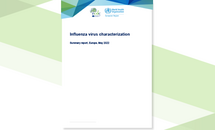Influenza virus characterisation - Summary Europe, October 2021
This is the first report for the 2021-2022 influenza season. As of week 44/2021, only 965 influenza detections across the WHO European Region were reported to the European Surveillance System (TESSy); 86% type A viruses, with A(H3N2) 97%) dominating over A(H1N1)pdm09 (3%) and 14% type B viruses with none having been ascribed to a lineage. This represents a large increase (926, 2 374%) in detections compared to the 2020-2021 season, on the back of a large increase (184 329, in the number of samples tested, and is close to the more usual number of detections seen in earlier seasons. This is probably related to the emergence of SARS CoV 2 and measures introduced to combat it.
Executive Summary
This is the first report for the 2021-2022 influenza season. As of week 44/2021, only 965 influenza detections across the WHO European Region were reported to the European Surveillance System (TESSy); 86% type A viruses, with A(H3N2) 97%) dominating over A(H1N1)pdm09 (3%) and 14% type B viruses with none having been ascribed to a lineage. This represents a large increase (926, 2 374%) in detections compared to the 2020-2021 season, on the back of a large increase (184 329, in the number of samples tested, and is close to the more usual number of detections seen in earlier seasons. This is probably related to the emergence of SARS CoV 2 and measures introduced to combat it.
Since the September 2021 characterisation report, two shipments from EU/EEA countries Croatia and the Netherlands containing 18 influenza related samples were received at the London WHO Collaborating Centre, the Francis Crick Worldwide Influenza Centre (WIC). This report therefore focuses on genetic characterisation of HA genes of representative seasonal influenza viruses submitted and/or released in Global Initiative on Sharing All Influenza Data GISAID up to 31 October 2021, together with sequences recently determined at the WIC. The genetic clade nomenclature system adopted during the September 2021 vaccine composition meeting VCM is used throughout the document. The data continued to show low levels of influenza detections globally but with a predominance of A(H3N2) viruses.
While the majority of A(H1N1)pdm09 detections have been in the 6B.1A.5a.1 subgroup, represented by the vaccine virus for the northern hemisphere 2020-2021 season, A/Guangdong Maonan/SWL1536/2019 60, recent detections of 6B.1A.5a.2 viruses have been reported in India. A/Victoria/2570 like and A/Wisconsin/588/20 19 like (6B.1A.5a.2) viruses have been recommended respectively for egg and cell based vaccines in the 2021-2022 northern and 2022 southern hemisphere influenza seasons.
The great majority of recently detected A(H3N2) viruses have fallen in subgroup 3C.2a1b.2a, being split between Cambodia like (3C.2a1b.2a.1) and Bangladesh like (3C.2a1b.2a.2) viruses, with 3C.2a1b.2a.2 viruses being in the ascendancy. A/Cambodia/e0826360/2020 like (3C.2a1b.2a.1) viruses were recommended for use in the 2021-2022 northern hemisphere season, while A/Darwin/9/2021 like and A/Darwin/6/2021-like (3C.2a1b.2a.2) viruses were recommended for egg- and cell-based vaccines in the 2022 southern hemisphere season. Recently detected viruses in the Netherlands were Bangladesh-like genetically and antigenically.
The vast majority of B/Victoria-lineage HA sequences derived from viruses collected after 31 January 2021 were subclade V.1A.3, represented by B /Washington/02/2019, the vaccine virus recommended for inclusion in influenza vaccines for the 2021-2022 northern hemisphere season. The vast majority of these viruses have fallen in the HA1 N150K, G184E, N197D and R279K amino acid substitutions group (V.1A.3a) being split between the HA1 V220M and P241Q (V.1A.3.1) and HA1 A127T, P144L and K203R (V.1A.3.2) subgroups, with the latter subgroup becoming dominant. B/Austria/1359417/2021-like (V.1A.3.2) viruses have been recommended for use in the southern hemisphere 2022 influenza season. Antigenically, viruses in subgroups of the V.1A.3a group differ and show some loss of reactivity with post-infection ferret antisera raised against B/Washington/02/2019.
No B/Yamagata-lineage HA sequences from clinical specimens collected in 2021, and none with collection dates after March 2020, were available. All of the 77 sequences from viruses detected in 2020, inclusive of 12 from EU/EEA countries, belong to genetic clade 3 Y3 and carry three HA1 amino acid substitutions (L172Q, D229N and M251V) compared to B/Phuket/3073/2013-like viruses which have been recommended for use in quadrivalent influenza vaccines for the 2021-2022 northern hemisphere and 2022 southern hemisphere seasons. The antigenic effects of these amino acid substitutions have been minimal as assessed in earlier reports.
Download








